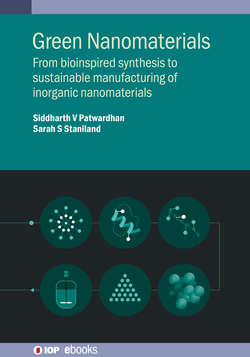Читать книгу Green Nanomaterials - Siddharth Patwardhan - Страница 19
На сайте Литреса книга снята с продажи.
2.3.1 Optical: surface plasmon resonance
ОглавлениеA surface plasmon is the interaction of the free surface electrons of a metal with electromagnetic radiation. Surface plasmons are mostly seen in inert noble metals, but all metals and even some highly doped semiconductors will exhibit a surface plasmon effect. When a metal surface is irradiated with light of a larger wavelength than the size of the particle, the conducting electrons will polarise and collectively oscillate about the surface of the particle in response to the wave, and are thus driven to form a resonance standing wave, giving a resonance peak (figure 2.5(i)). This is known as SPR. At this peak the electromagnetic radiation is both scattered and absorbed by the metal [2]. Some of the radiation is absorbed by the nanomaterial and converted to crystal lattice vibrational energy (phonons), while the rest of the radiation is emitted in different directions (scattering).
Figure 2.5. (i) Schematic of how electromagnetic wave interacts with surface electrons on a nanoparticle (adapted from figure in [2] with permission of the Royal Society of Chemistry). (ii) Regions of the electromagnetic spectrum that specific nanomaterials of different morphologies emit due to SPR (adapted from figures in [3] with permission of Springer).
The colour of the light emitted comes predominantly from the scattering, so we should consider what contributes to the SPR scattering. We need to think about polarisability; the ease with which charges (the conduction electrons) on the nanoparticle surface undergo charge (re)distribution and form partial dipoles. This is dependent on how far the electrons need to move, i.e. the cross-sectional area (so in turn, the radius of the particle (r)). It also depends on the nanoparticle material, and how easy electrons can move on this metal: the dielectric function of the nanoparticle (ε = ε1 + iε2) (wavelength dependent) and the dielectric function of the medium (εm) in direct contact with the surface. This can be quantitatively described by the Gustav Mie theory of light scattering for any spherical particles with radius = R, for which a simplified version (when 2R ≪ λ) is shown in equation (2.3)
Cext=24π2R3εm3/2λ·ε2(ε1+2εm)2+ε22.(2.3)
Here Cext is the extinction cross-section and gives the quasi-polarizability of the nanoparticle. SPR is a property of nanomaterials due to the scale of wavelength verses particle size, and the increased surface area offers a more pronounced effect. Furthermore, the wavelength of the resonance peak and thus the colour emitted by the SPR is dependent on the components highlighted above, the primary ones being the particle composition (material), and the radius. However, what equation (2.3) does not describe is the effect of shape/architecture, as the Gustav Mie equation is only for a simple spherical particle. Surface plasmons are highly dependent on the overall surface architecture, and not limited simply to size. Varying morphology affects the SPR frequency and thus emission since varying the shape alters the surface architecture and this alters the electric field distribution on the surfaces, again altering the surface plasmon resonance. This tends to result in an increase in the range of resonance frequencies; this is certainly true for cubes, rods, cages/shells and egg shapes (figure 2.5(ii)). Furthermore, all other volumes have a larger surface area to volume ratio than a sphere, so all other shapes will offer increased surface area. This is particularly true for hollow shapes like cages.
The classic historical example is gold nanoparticles. Spherical gold shows a range of colour dependence on size, from green for particles around 5 nm, up to red for particles of about 50 nm (figure 2.5(ii)). However, silver spherical nanoparticles have higher frequency SPR resonance (higher energy), emitting from green up to ultraviolet compared to gold nanoparticles of the same size and shape (gold emitting red to green), demonstrating the dependence SPR has on material as well as the size. Finally, since this is a surface effect and the surface is interacting with the surrounding media, we cannot forget the SPR frequency dependence on the dielectric constant of the media. Furthermore, SPR is affected by the locality of near materials exhibiting SPR [4]. Both are incredibly useful for applications as colorimetric indicators/sensors as very subtle changes to either the nanoparticle surface, the surrounding media, or the distance nanoparticles are from each other can be optically detected. In addition, SPR is so intense that the scattering of a single nanoparticle can be seen by the eye in an optical scattering microscope. The blue light emitted by a silver nanoparticle has a cross-sectional area a million times greater than the dye molecule fluorescein, making noble metal nanoparticles exhibiting SPR very attractive materials for ultra-sensitive sensors [4]. There have been many excellent tutorial papers and reviews on SPR that the reader is directed to for more in-depth explanation, as well as the many applications, from sensing to in vivo and in vitro biomedical applications [2–5].
